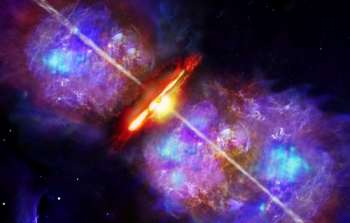sci16071 — Announcement
Are All Stars Created Equal?
November 15, 2016
Artist's impression of an accretion burst in a high-mass young stellar object like S255 NIRS 3. Image Credit: Deutsches SOFIA Institut (DSI).
Researchers using critical Near-infrared Integral Field Spectrograph (NIFS) observations from the Gemini North telescope have found the strongest evidence yet that the formation of massive stars follow a path similar to their lower-mass brethren. The new findings, that include data from Gemini, SOFIA, Calar Alto, and the European Southern Observatory, show that the episodic explosive outbursts within accretion disks, known to occur during the formation of average mass stars like our Sun, also happen in the formation of much more massive stars.
The international team of astronomers (led by Caratti o Garatti, of the Dublin Institute for Advanced Studies, Ireland) published their work in the November 14th issue of the journal Nature Physics. The work presents the first clear case that massive stars (in this case one about 20 times our Sun’s mass) can form from clumpy disks of material – in much the same way as less massive stars. Previously it was thought that the accretion disks seen around lower mass stars would not survive around stars of higher mass due to their strong radiation pressure. Therefore, some other process would be necessary to account for the existence of more massive stars.
See the full Gemini press release here and find the paper online at: http://dx.doi.org/10.1038/nphys3942 (subscription required).
About the Announcement
| Id: |
ID
sci16071
|
